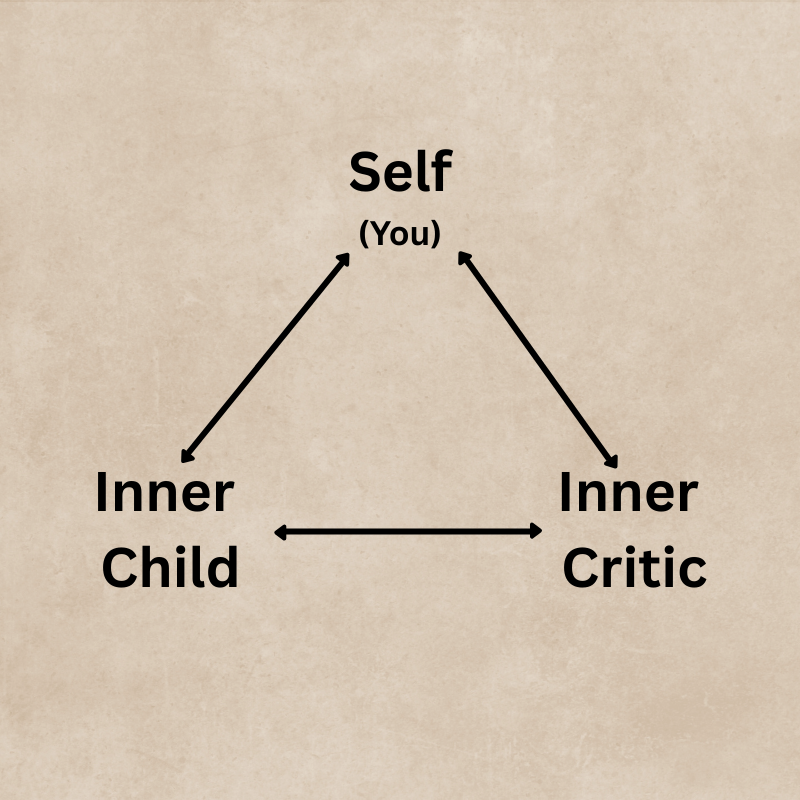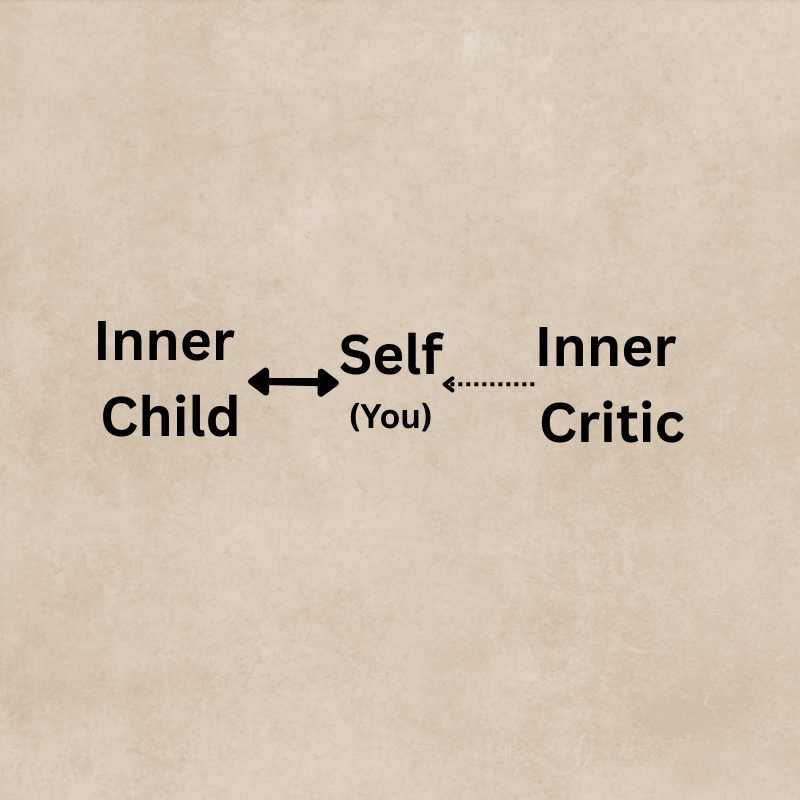Protecting Your Inner Child from the Inner Critic
You’ve unblended from your inner critic — you no longer see yourself as the critic and don’t believe wholesale what they have to say. You’ve connected with your inner child — you can find them in your body and send them love. Nevertheless, you still find yourself being wounded by the critic and getting caught in spirals of shame and self-criticism.
What’s happening? Why are you still getting hooked?
In short, the reason the critic’s words still wound you is because the critic isn’t just talking to you, they are also sending that criticism towards your inner child. While you may know that you are “good enough”, the child is still vulnerable to the unkind words from the critic. That younger part keeps getting hurt all over again — feeling unseen, unloved, and “not enough.”
The good news is this: you don’t have to silence or destroy the critic to protect your inner child. In fact, arguing with your inner critic rarely works. A more effective and healing path is to stand with your back to the critic and focus your attention on the inner child holding the shame, and to offer them the love and compassion they never received.
This is an incredibly powerful method for pulling out of a shame spiral and healing from chronic shame in the long-run using Internal Family Systems (IFS) Therapy.
The Inner Critic and the Inner Child: A Painful Dynamic
By now you are hopefully intimately familiar with the voice of the inner critic. It might sound like:
“You’re so lazy—why can’t you get it together?”
“You’ll never be good enough, no matter how hard you try.”
“No one will ever really love you.”
“You should be past this by now.”
This voice doesn’t come out of nowhere. It often forms in childhood—internalized from caregivers, teachers, or environments that were overly critical, shaming, or emotionally neglectful. The inner critic becomes a kind of internal authority figure, mimicking the voices that once had power over us.
As a result, the inner critic is often paired with an inner child part which is still frozen in the time where this harsh inner criticism was needed to protect you from further harm. Now that the environment in which it was formed is over, both of these parts are still stuck in that same dance.
That inner child may be holding on to wounds from years ago—feelings of abandonment, humiliation, fear, or longing. When the critic attacks, it’s this child part who absorbs the pain.
Why Arguing with the Critic Doesn’t Work
Many people try to deal with the inner critic by arguing with it. They try to “prove it wrong” or push back with affirmations or logic:
“I am doing enough.”
“That’s not true—I’ve accomplished a lot.”
“I don’t need to listen to you.”
While this can sometimes be helpful, it rarely brings lasting relief. That’s because the critic isn’t interested in truth—it’s interested in control. And when you argue with it, you’re still engaged in a power struggle on its terms.
Instead of fighting the critic, shift your focus. Ask yourself:
What part of me is feeling hurt or shamed by this voice right now?
Can I find the younger self that needs my care?
This redirection is powerful. It takes you out of reactivity and into compassion. It reminds your system that you are not the critic—you are the one who can protect and care for the child the critic is targeting.
How to Protect the Inner Child Through Compassionate Presence
The most powerful thing you can do is to turn your attention away from the critic and toward the part of you that feels ashamed, small, or afraid. This may be a child version of yourself—5 years old, 9 years old, even 15—who once internalized the belief that they were unworthy or unlovable.
When you connect with this part from a place of compassion, you break the cycle. Instead of the inner child being wounded again by the critic, they are seen, held, and protected by your loving awareness.
Here’s how to do this in practice:
Step 1: Notice When the Critic Is Active
The critic often speaks in absolutes, like “always” or “never.” You might notice it when you feel sudden shame, self-doubt, or the urge to overperform. Instead of engaging, pause and say to yourself:
“A critical part is active right now. This isn’t the truth of who I am—it’s a protective pattern.”
Step 2: Redirect Your Attention to the Wounded Part
Ask yourself:
“Who inside me is hurting right now?”
“What age does this part feel like?”
“Where do I feel this part in my body?”
Maybe there’s a heaviness in your chest, a sinking feeling in your belly, or a tension in your throat. These are somatic doorways to the inner child who’s feeling targeted.
Step 3: Offer Presence, Not Perfection
You don’t need the perfect words. You don’t have to fix anything. Just be with that younger part the way a caring adult might comfort a child.
You can say things like:
“I see how hard this is for you.”
“You didn’t deserve to be treated that way.”
“I’m here with you now, and I’m not going anywhere.”
Place a hand on your heart or wherever you feel the child in your body. Offer warmth through touch and attention. You often don’t even need the words, just sending the child your love and care is enough.
Step 4: Set a Boundary with the Critic
From this compassionate stance, you can turn to the critic part and say:
“You’re not allowed to speak to them like that anymore.”
“I understand you’re trying to help, but this is not helping.”
“I’ve got this now—you don’t need to take over.”
You may notice the critic softening when it sees that the Self—your wise, grounded core—is stepping in. It may even reveal its fears or exhaustion. In time, you can build a relationship with this part too. But first, your job is to protect the child.
What Healing Looks Like Over Time
As you consistently redirect your energy from the critic to the inner child, several things begin to shift:
The critic loses power, because it's no longer the primary voice being listened to.
The inner child gains trust, realizing there is finally someone who will show up for them.
Self-compassion becomes more accessible, because you're no longer fused with shame.
Emotional reactivity softens, because your system feels safer and more integrated.
You’re not just thinking differently—you’re relating to yourself differently.
A Real-Life Example
Imagine you make a mistake at work. The inner critic instantly attacks:
“You’re so careless.”
“You’ll never be taken seriously.”
“They’re going to find out you’re a fraud.”
Rather than trying to convince the critic it’s wrong, you pause. You notice a sinking feeling in your chest and an image of your 10-year-old self who was scolded harshly for making mistakes. You turn to that part and say:
“Of course this feels scary. You were yelled at and humiliated back then. But I see you now. You’re safe with me. I don’t expect you to be perfect.”
Your body softens. Your breath deepens. The shame begins to lift—not because you silenced the critic, but because you comforted the child.
You Are the Protector Now
The inner critic may have helped you survive, but it cannot help you heal. Healing begins when you shift your attention away from the voice of shame and toward the one who still carries the wound.
Your inner child doesn’t need you to win arguments with the critic. They need your presence. Your warmth. Your protection.
Every time you respond to shame with compassion, you reinforce a new pattern: one where your inner child is no longer alone, no longer blamed, no longer invisible.
You become the caregiver they’ve always needed. And in that relationship, true healing begins.
Continue the Series
This article is Step 3 in my four-part series on healing chronic shame with Internal Family Systems (IFS) therapy.
If you’re just joining, start with:
• Step 1: Unblending from Your Inner Critic
• Step 2: Connecting with Your Inner Child — A Somatic Approach to Emotional Healing
Continue the series with:
• Step 4: Befriending Your Inner Critic
Ready to Heal Shame at the Root?
If you’re struggling with low self-confidence, chronic shame or self-criticism, I have a customized approach that can help you reconnect with the parts of yourself that long for compassion and belonging.
Learn more about my approach to Therapy for Shame here.
Learn more about Internal Family Systems (IFS) therapy here.



